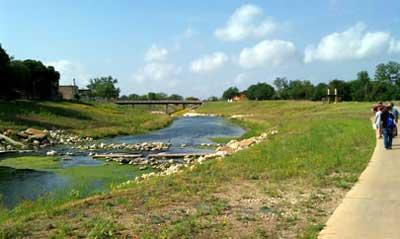"A river runs through it" could describe San Antonio Missions National Historical Park, but the current version of the San Antonio River bears little resemblance to the winding waterway of years past. The first phase of a project to both restore the river to more natural conditions and create improved trails and public access has just been completed, and it's a big step forward.
The river was a key factor in the decision by the early Spanish settlers to locate in the area. The park website notes, "San Antonio Missions National Historical Park was established to preserve and interpret the chain of Spanish missions that were built along the San Antonio River in the 18th century."
"This river contains a vital natural resource element - water. The existence of water dictated where a mission was established. Water from the river was diverted into eighteenth century acequias (irrigation ditches, still in operation) to serve the mission communities."
That scene gradually changed as the city of San Antonio grew, but the landscape was altered drastically when much of the river was straightened and channelized as part of a flood control project in the 1960s. Remnants of the old river channel still remain, however, and for nearly two decades, work has been underway to restore parts of the river to more natural conditions.
In 1988 officials from Bexar County, the City of San Antonio and San Antonio River Authority (SARA) created the San Antonio River Oversight Committee. The outcome was The San Antonio River Improvements Project (SARIP), which seeks to balance improvements in flood control, amenities, ecosystem restoration and recreational opportunities along 13 miles of the river both north and south of downtown.
The project is divided into four segments, or "reaches," and the one most important to the park is known as the Mission Reach. This eight-mile section of the river encompasses the entirety of San Antonio Missions NHP between Mission Concepción to the north and Mission Espada to the south.
Slated for completion by August 2013, the project will link the park directly to San Antonio’s famed Riverwalk and previous restoration efforts north of downtown. When work is finished, San Antonio Missions NHP will be part of a 2200-acre urban park connecting city, county, state and federal parklands into one cohesive park connected by hike and bike trails and the San Antonio River.
Secretary of the Interior Ken Salazar was on hand on June 25 to help open the first two phases of the Mission Reach. In his remarks, Secretary Salazar announced he would be supporting San Antonio’s efforts to nominate the historic Spanish missions of San Antonio as a World Heritage Site.
“I'm ready to sign off today,” Salazar told a crowd of several hundred residents and local dignitaries at the grand opening as hundreds more walked, biked, and strolled the newly restored section of the San Antonio River. “San Antonio deserves this recognition because you have set an example for the nation and the world.”
“San Antonio National Historical Park preserves the four missions that not only represent the cultural roots of this great city, but also the single largest concentration of Spanish Colonial resources in the United States and perhaps in the Western Hemisphere,” Secretary Salazar said. “This exceptional site merits the same international designation already given to places like the Statue of Liberty, Independence Hall, and Yellowstone National Park.”
Secretary Salazar also took time to tour Mission San José, where he took part in grinding wheat in the Mission San José gristmill, the oldest mill in Texas. He then addressed a crowd of park supporters, park partners, local residents, and visitors for over an hour in the park’s newly renovated theater in the visitor center.
In addition to the four missions comprising San Antonio Missions National Historical Park, San Antonio’s other Spanish mission, Mission San Antonio de Valero—known popularly as the “Alamo”—is also part of the World Heritage nomination. There would be no change in control of the Alamo by the Daughters of the Republic of Texas as a result of the nomination.




Comments
What a great article. As a local resident since 1945, I love San Antonio and I am so excited about what they are doing with the River. It is a dream come true. Thank Goodness we have a very active Conservation Society. I am a Real Estate Broker and I, personally, am a One Woman Army Conservation Society, saving our Inner City Housing Stock. We have a lot of homes that carry the Historic Designation and we also have 4 - 5 Historic Neighborhoods, with more being added. We also have very active Neighborhood Associations. I would love to see a resurgence of our Downtown of the 40's and the 50's, before the advent of the Suburban Malls.
Anyway, thank you for the wonderful article about our beautiful City.
Hope they can do something with the old Bergs Mill Bridge. Too many people dumping trash over the side in what looks like it could be a really nice spot.